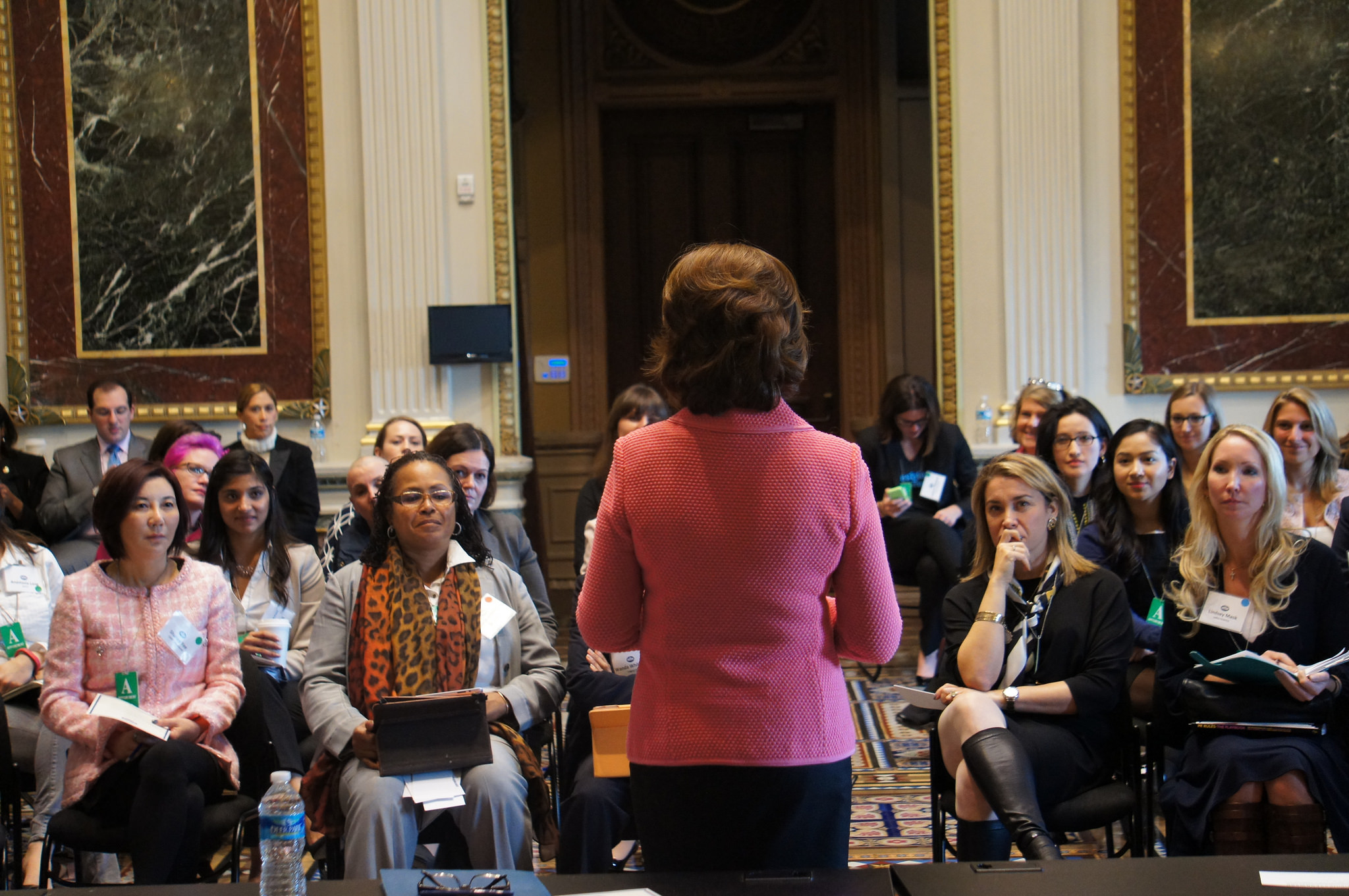People ask me sometimes, ‘When do you think it will be enough? When will there be enough women on the court?’ And my answer is when there are nine.
When we think about women leaders, we often think about CEOs and board members of the Fortune 500. There are 27 women leading Fortune 500 companies in 2017. For the first time ever, 5 percent of the Fortune 500 CEOs will be women. When it comes to boards, “in the 810 active GDI companies, women hold 19.7 percent of board seats, an increase from 18.8 percent in 2015, and from 14.6 percent in 2011.”
Women are consistently becoming more visible in larger corporations. Meg Whitman, CEO of HP and now HPE, has led a challenged company through a turnaround and split. During her tenure, she encouraged diversity within HPE’s board. She influenced the board to include 5 women on a board of 14 and increased diversity in all ways.
Video Credit: Hewlett Packard Enterprise
But there is still work to be done. It is predicted that it will be another decade before 40 percent representation on Fortune 500 boards is reached for women and minorities. But do stats like this about the Fortune 500 represent the complete story of women business leaders?
Beyond the Fortune 500
The Fortune 500 is just that – the top 500 profitable US companies. These stats exclude the small and midsize companies where most of America is employed.
- How many people work in small and midsize companies?
In 2012,according to U.S. Census Bureau data, there were 5.73 million employer firms in the U.S. - Firms with fewer than 500 workers accounted for 99.7 percent of those businesses, and businesses with less than 20 workers made up 89.6 percent.
- Add in the number of nonemployer businesses– there were 23.0 million in 2013 – then the share of U.S. businesses with less than 20 workers increases to 97.9 percent.
SBE Council: Small Business Facts & Data
So what’s happening in these 5.73M firms regarding women leadership?
- Over the past nine years, the number of women-owned firms has grown at a rate fully five times faster than the national average
- Employment in women-owned businesses has increased by 18 percent since the recession, while among all businesses employment has declined 1 percent since 2007.
- Business revenues among women-owned firms have increased by 35 percent since 2007, compared to 27 percent among all U.S. firms (women-owned firms have increased at a rate 30 higher than the national average).
- Women are now the majority owners of 38 percent of the country’s businesses, up from 29 percent in 2007. These firms employ 8 percent of the nation’s private sector workforce – up from 6 percent nine years ago – and contribute 4 percent of the nation’s business revenues, a share that has not changed over the past 20 years.
In the Photo: Women in business at the White House. Photo Credit: Flickr/Business Foreward
The State of Women-Owned Business Report, Commissioned by American Express OPEN
Women are majority owners of 38 percent of the country’s businesses. That’s 12 percent away from 50 percent. I think we sometimes forget that not even 50 years ago, men owned close to 100 percent of the businesses. This demonstrates how quickly women are stepping up, starting businesses, and leading.
Boards and Leadership
I spoke with Sheila Ronning of Women in the Boardroom about women in Fortune 500 boards and beyond. She is a board strategist, working with boards of all-sized companies to determine board structure and help organizations reach their goals, as well as a leadership and networking expert. Women in the Boardroom as an organization encourages women to assist other women in achieving their leadership and corporate board service goals. In less than 15 years, she has scaled Women in the Boardroom from concept to a membership organization with global reach to the Fortune 100.
Frequently, organizations will send her organization board openings as part the networking process to find board members. She’s in a unique position to understand what’s happening with boards because she gets notified of these openings, passes them on to her membership, and often hears about the results.
When I asked her why there aren’t more women on Fortune 500 boards she responded, “Few are qualified for the Fortune 500 board rooms, men or women.”
Most of us generally understand a CEO’s role and responsibilities, but I think it’s a little unclear what board responsibilities are for public or private companies. From reading a number of definitions, boards of directors exist:
- to hold management accountable for achieving the business plan
- to set the mission and vision of the corporation
- to set policy for corporate officers and employees
- to create shareholder value
- to assist the owner/CEO in growing the enterprise
In the Photo: Women attend the Most Powerful Women Summit in Washington, D.C., with panel experts Wendy Clark, Senior Vice President, Global Sparkling Brand Center, The Coca-Cola Company; Ann Hand, Chief Executive Officer, Project Frog; and Megan Smith, Vice President, Google[x]. Photo Credit: Stuart Isett/Fortune Most Powerful Women
They provide advice and counsel, but their primary function is to ensure accountability. A strong board can help a young company build credibility. Board members aren’t really involved in the day-to-day operations of the company. However, if there are risky business decisions made, they may be held personally liable for negligent management.
Being on a Fortune 500 or public company board is very different than a private board. Public boards have traditionally focused on corporate governance. Legislation like Sarbanes-Oxley requires companies to include a set number of directors with financial knowledge who aren’t affiliated with the company. Most board members have experience in finance, legal, and operations. Many gained this experience by managing large P&L centers as a general manager, managing director or division VP, or being a CEO, CFO or COO.
Related article: “THE STEM CLUB: ARE FEWER WOMEN JOINING?”
According to Sheila, modern public company boards are embracing greater experience diversity to include areas like marketing, risk management, technology, and talent management. This is opening opportunities to those who may not have been qualified in the past due to their lack of financial experience. It’s almost more difficult for anyone – male or female – to be on a Fortune 500 or public company board than it is to be a CEO with all the requirements.
Private company boards are similar, yet very different, than public company boards. They aren’t obligated to have outside directors since the financial rules don’t always apply. Rather than providing corporate governance and represent shareholders, the role of a private company board is to balance and complement a company’s executive expertise and help the company set its strategy in the market. Professionals with entrepreneurial experience and an understanding of operating issues for growing companies are usually targeted for these boards.
In the Photo: Fortune’s Most Powerful Women Summit Photo Credit: Flickr/U.S. Chamber of Commerce
An alternative choice for private companies that can’t afford an external board but want 3rd party advice is an advisory board. It can help provide a different perspective before making a final decision.
Sheila mentioned that depending on your background and expertise, being on the board or advisory board of a private company may be more suitable and rewarding than targeting a board seat at public company. It can be more fun and hands-on to help shape a new company than govern a larger body through regulations. Being on the board of a private company can also be a stepping stone to a board seat on a Fortune 500 company. It all depends on what you are looking to do.
How many women are on the board of private companies? Unfortunately, it can be difficult to get representation statistics from smaller and private companies and determine if women are involved on these boards. However, if we expand to the Fortune 1000,
Of the Fortune 1000 companies with a female CEO or Board Chair, 88 percent and 86 percent of companies respectively have already met or surpassed 2020 Women on Boards’ goal of having 20 percent or more women on the board. This compares to 42 percent of all Fortune 1000 companies.
—Boardroom Diversity: When Women Lead, 20 percent by 2020 Women on Boards
Photo Credit: Flickr/Women of Color in Tech
How do you become a board member?
I asked Sheila what it takes for companies to find a board member. She told me that when a company is ready and looking, they will first reach out to a search firm for help. And at the first meeting, the first question a search firm will typically ask the company, ironically, is: “Who do you know who would be interested?”
To sum it up, board members are identified and hired through networking.
This is great news for women because, as Sheila pointed out, women are great at building relationships and networking. However, where this strategy fails for women is that they use their network for permission and advice rather than finding the right board job.
She gave an example. A woman who is interested in joining a board may tell a male colleague that she is interested in a board position and ask him if he knows of any openings. Rather than leaving it there, she may continue the conversation and ask him for advice on her resume and background to determine if her materials has her on the right track. With that final question, she went from searching for a board position to asking for mentorship to join a board. Most likely, that male colleague will help her position herself for a board seat, but he may not recommend her for a position because he doesn’t see her as a candidate – she is someone who needs help.
How do we improve the numbers? Confidence vs courage vs competence
Internal research by Hewlett-Packard found that women only apply for jobs for which they feel they are a 100% match; men do so even when they meet no more than 60% of the requirements.
—The Feminist Mystique, The Economist
Some argue, based on this metric above, that women don’t have the confidence to apply for “stretch” jobs. However, after further research, this quote is based on a more interesting factor: applying only for jobs where they meet all of the qualifications. Many women assumed that the qualifications were mandatory and didn’t want to waste their time if they didn’t meet all of them (and this was around 40 percent for each gender).
That has very different implications for women. There are 3 perspectives to this:
- The women didn’t understand the job process and that the qualifications were recommendations and nice to have, used as a guide to help with filtering candidates.
- The job description wasn’t clear enough to indicate that the qualifications were recommendations.
- The women didn’t have the courage to apply for a job that they weren’t 100 percent qualified to do, even though the description was appealing and something they believed they could do.
In the Photo: 40 percent of women don’t apply for jobs unless they meet all of the qualifications. Photo Credit: Flickr/Women of Color in Tech
Getting a board seat is similar to applying to a job where you don’t meet all of the qualifications. Sometimes, a board may be looking for an individual with specific skills but given your experience and what you can offer, even though they don’t match the specific request, you are the perfect fit. Trying to be that perfect fit is what holds women back and causes them to shift a search inquiry into a mentorship opportunity.
And, according to Sheila, it is this mentality that holds women back. Return to the story of the woman asking for advice about her resume for a board position rather than asking to be recommended for openings. By asking for advice, women don’t push themselves out there for a position. We hear from research that this is due to a confidence gap – women don’t believe that they are worthy. The imposter syndrome strikes again. But is it truly a confidence gap? Or is it really a courage gap?
Shannon Muruli, a life coach who specializes in courage to overcome fear, disagrees with the confidence versus competence argument. She acknowledges the confidence/competence loop, but at the same time asserts that it takes courage to step up and make a change. There is a great story in her book, “DoItAfraid“, about a young woman who always sat in the back of the room at this large meeting. Each week, she challenged herself to sit one row closer to the front of the room. Over a few weeks, she was in the front of the room. Then she stood up to respond to something someone was saying at this meeting. Her words were brilliant and she sounded eloquent. Reporters approached her after the meeting because she was so knowledgeable and a new expert for them to contact. Now, she travels abroad with her business teaching women how to start and grow business. And she does this because she had the courage to sit one row closer to the front of the room and speak up at a meeting.
She has a point. If we look at the definitions of courage and confidence, something pops out right away:
Confidence: a feeling of self-assurance arising from one’s appreciation of one’s own abilities or qualities.
Courage: the ability to do something that frightens one; bravery.
Definitions from the Oxford English Dictionary
It may be a waste of time to apply for a job where you don’t have 100 percent of the qualifications. You may have confidence in your abilities but that’s not what is truly holding you back. Instead, you are afraid of rejection because you don’t meet the criteria. Why be brave and leave your comfort zone if there is a strong chance of immediate rejection? Fear makes for a great excuse.
Women need to be able to look at the job post and say to themselves, “I can do that,” rather than “why bother if I don’t meet all the requirements.” We don’t know for sure if the women who didn’t apply felt they could have done the job anyway (so why bother? And it’s a great excuse not to try if you aren’t 100 percent qualified) or if they really felt that they needed 100 percent of the requirements and didn’t fully understand the process. In the end, it’s up to the individual to know how they are feeling. But women need to be aware that the thinking in both scenarios is very different and a factor as to why some don’t take that leap.
Photo Credit: Pexels
The Amazing Dozen – shining their light of possibilities
There are 12 women who are on 48 boards
- Eleven sit on 4 boards in the Fortune 1000. Patricia Russo sits on 5 boards in the Fortune 1000.
- All are independent directors.
- The average age is 63.
- Three of the twelve are African-American.
- Two are attorneys; three are CPAs/CFOs; two are politicians; five were CEOs.
—Boardroom Diversity: When Women Lead, 20 percent by 2020 Women on Boards
These women are exceptional based on their backgrounds but also because they stepped up and took the challenge to apply to be members of predominately male boards. They demonstrated that with great achievement and a lot of courage, a woman can sit on at least 1, but up to 4-5 boards successfully. They are role models for us to see what’s possible if we have the courage to take that step forward.
Are women doing as poorly as we are led to believe according to the stats?
No. As a reality check, return to the quote by Ruth Ginsberg. The background behind it is that men have been running things so long that we think 50 percent is enough. We are used to men only boards, executives and leaders. But women are opening businesses at an amazing rate – 1.5 times that of men – and that’s only in the past few years. Five percent of the Fortune 500 CEO seats are filled by women and 31 percent of the Fortune 500 board seats have gone to women and minorities. Women are doing fantastic and truly catching up!
From my perspective, women believe that we aren’t doing well because we’re constantly reminded we need to do better. What if we were told that we were doing great and needed to strive to the next goal and increase our numbers instead?
We don’t acknowledge how long we have been told that men “run” things. In history classes, women need to do their own research to find women leader role models; we don’t often learn about leads like Hatshepsut of Egypt or the Trung Sisters of Vietnam. A lack of women role models in leadership roles indirectly influences women to not step up to lead. It’s harder to have the courage to do something that you don’t believe is possible to do. Role models make the impossible, possible.
However, women are persevering. Women are catching up and repositioning ourselves after years of programming and conditioning to view ourselves in a supporting role. We need to learn to have the courage that men have always had to step up and lead. We have the competence. Many of us have the confidence. The last piece is the courage.
Sheila noted that she’ll know that things have changed for women when “Women in the Boardroom” needs to be renamed to “Men in the Boardroom” or “People in the Boardroom.” “When men start to need advice to get a board seat, that means that women are equally competitive.” And just for the record, she does occasionally get phone calls from men.
Recommended reading: “THE POWER OF THE PURSE”















